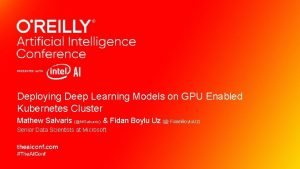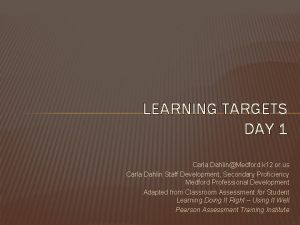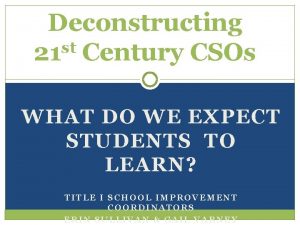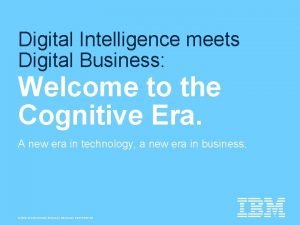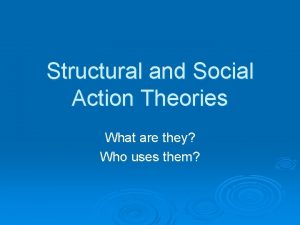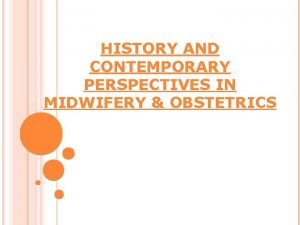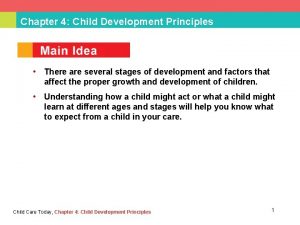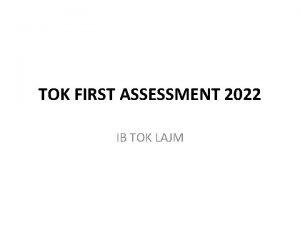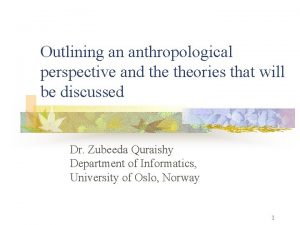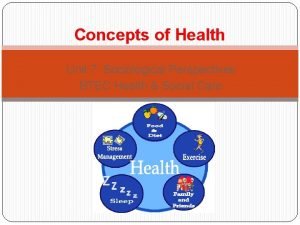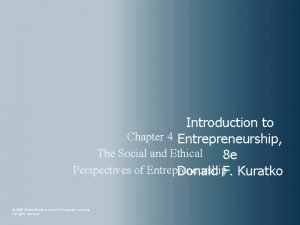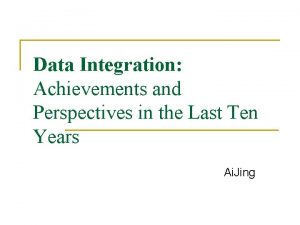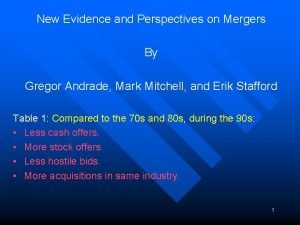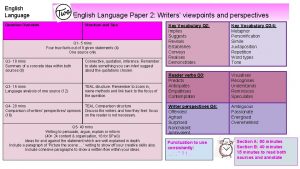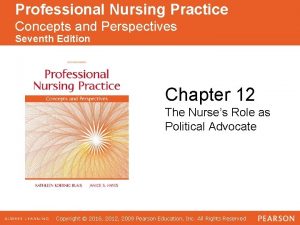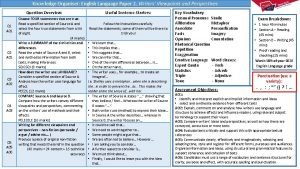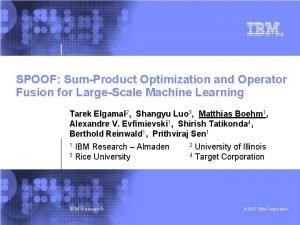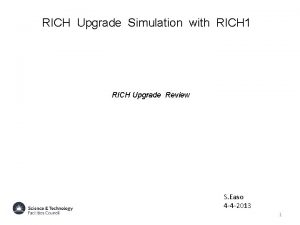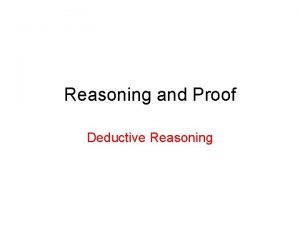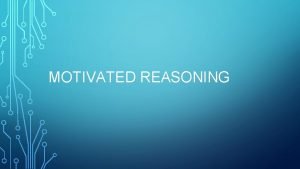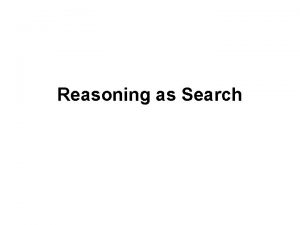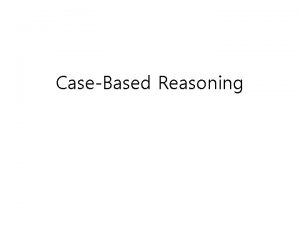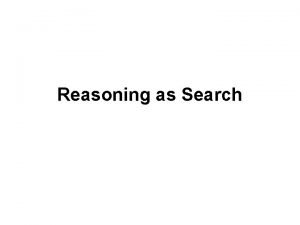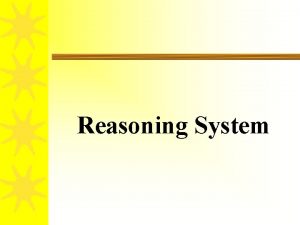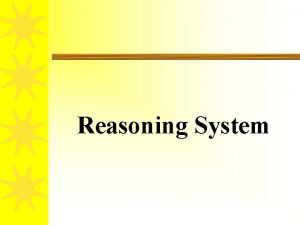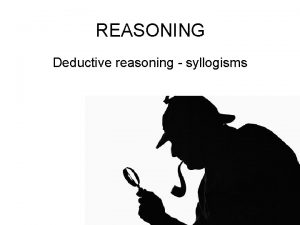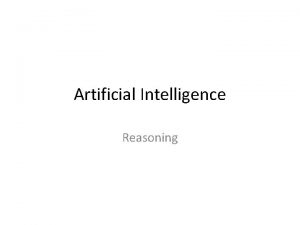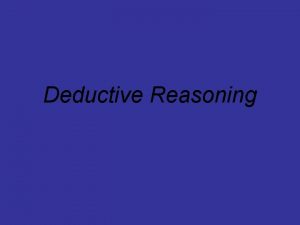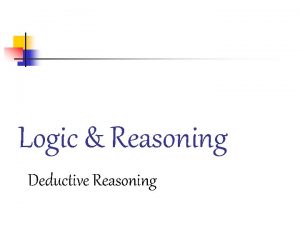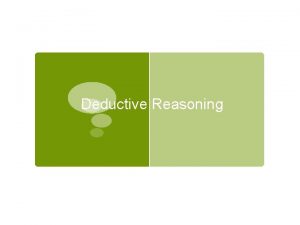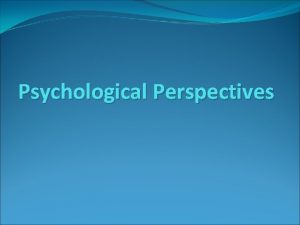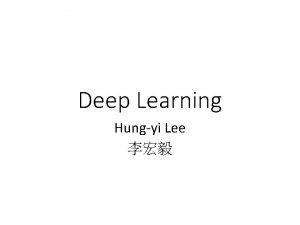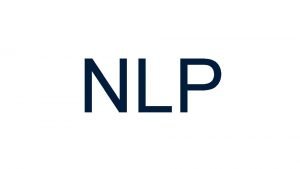Perspectives on deep learning and deep reasoning RICH



































- Slides: 35

Perspectives on deep learning and deep reasoning RICH HANEY RICH@BIGDATA 2. NET BIG DATA 2 CONSULTING `

Perspectives on deep learning and deep reasoning I. Perspectives based upon different ideas about tensors A. Perspectives using tensors as geometric objects -- really objects from differential geometry B. Perspectives from abstract algebra II. Perspectives that combine approaches from logic, type theory, and topology A. Perspectives using models of reasoning by V. Voevodsy B. Perspectives using models of reasoning by B. Jacobs III. Perspectives involving deep neural nets and classical models of inquiry A. Perspectives on deep neural nets that come from classical modes of inquiry B. Perspectives on classical models of inquiry using approaches of deep neural nets

I. Perspectives on tensors 1. In geometry: tensors are geometric objects*-- really differential geometry 2. In abstract algebra, they arise as abstract tensor sums and products, e. g. as A ⊗ B 3. In constructive logic / category theory, tensor products with composition - core building blocks of deductive systems. In physics, tensors are used to reason about space and time in physics; un engineering they define the structural properties of systems. There a number of points of view on tensors - a tensor is a concept of pluralistic nature. * Wikipedia definition of tensor: "In mathematics, tensors are geometric objects that describe linear relations between geometric vectors, scalars, and other tensors“. + In category theory, formal reasoning over one type is defined using composition and tensor product (⊗)

Different concepts tensors from differential geometry and algebra can inform different perspectives on learning http: //ruder. io/deep-learningoptimization-2017/ In a differentiable point of view, dimensions/layers of a system are differentiable. In differential geometry, the chain and product rules for differentiation also apply. In abstract algebra, learning could be decomposing into parts, e. g. , decomposing systems into different kinds of products and sum which constitute them. Tensor decompositions involves such decompositions. Learning is finding what is “best”, and, with the help of information geometry -- an extension of differential Here learning involves determining the parts – like taking apart a watch. geometry, what has the most information.

Can approaches using sum/product decompositions be as effective? http: //ruder. io/deep-learningoptimization-2017/ Question: are the two approaches ultimately “the same” ( as has been suggested)? Which would be better? In terms of basic definitions using tensors, there is much more structure in differential geometry. That’s why Einstein used tensors as they arise in differential geometry. But the more general answer is – as some authors also say -- a combination of both perspectives.

Additional perspectives on tensors from additional disciplines • Given kinds of tensor ( e. g. , elasticity tensors ) used in one field can be used in other fields as well. If one wanted to define a concept of transfer learning at a quite deep level, it would be hard to find a better example than that of tensors. • In 1969, George Forsythe, head of the Stanford Computer Science department, said "'What can be automated? ' is one of the inspiring philosophical and practical questions of contemporary civilization. “ Since that time, a certain percentage of that work on automating things has just involved matrices and tensors.

IIA. Perspectives using models of Vladimir Voevodsky • Here the goal is not just to recognize a car, but to understand its geometric structure, and its mechanical properties as well. What are its structural and mechanical properties? Here, in some sense, we would like to do computer graphics/CAD in reverse. • We don’t just want to recognize faces, but, understand the dynamic aspects of faces as well. • We would like to not only have a system that uses tensors, but have a system that knows tensor formulas and can derive ( prove ) those formulas. • Over the long run, approaches of models of Vladimir Voevodsky permit these.

Algebra and geometry in the work of Vladimir Voevodsky • Our earlier concept of tensors referred to algebraic ideas of tensor products. • In the geometric concept of tensors, tensors are geometric objects. They involve magnitudes and directions. But the algebraic perspective, they are not, say, “oriented”. • In another perspective that can be used for many kinds of tensors, the “algebraic products” ( unlike what is done in the previous approaches ) are geometric objects (geometric shapes), too. • This perspective, one of the concepts of Grassman algebra, is also one of those incorporated by Voevodsky. The approach makes for a particularly nice way to glue concepts of geometry, algebra, and logic together in practical ways.

Perspective in which the algebraic products are also geometric objects • In another approach, the algebraic products are also oriented: they have both magnitude and direction from the start. The products are also geometric shapes. • Examples are at right. They include examples from grade school geometry, e. g. , a cylinder is a “sweep” – a product of a circle and an altitude vector. • There is a local notion of “AND”, actually a “multiplicative AND”, a kind of tensor product. • But in GA we could actually have two kinds of ^ “AND”. If we want, maybe we could use or ⊗ • And there are different kinds of “OR” as well. We abstract the basic methods of grade school arithmetic and geometry, as in Geometric Algebra (GA) 3 x ˄ 2 = = 6

Logic relates to “linear logic” as fleshed out by Girard • Geometric algebra itself can be thought of having certain types with building blocks at right. • Another kind of AND than used in the previous slide is also the “intersection” or “meet” of shapes in geometric algebra. • The logic is a “linear logic” can apply to a number of application areas, not just geometric algebra. • Girard’s linear logic is one of a family of logics for monoidal categories.

“Glue theory” ( sheaf theory ) as used in approaches of Voevodsky • In our system, at helping us to some point, we want to store formulas, and, simply put, “prove things”. That is one way we can reason – and also justify our reasoning – at a more advanced level. • To glue together ideas from geometry and logic, we need some additional concepts. • One necessary component is use of another construction also crucial in other areas of constructive logic, that is, sheaf theory. • Sheaf theory is essential “glue theory” that can be used to glue different pieces of data (and also ideas) together. • It has been applied to high level processing by the visual cortex. One could hypothesize that this “glue theory” could be useful in deep learning approaches.

Dipping into “theory of glue” itself (sheaf theory)

Voevodsky pulls together ideas from type theory, proof theory, and other areas as well. This slide from Mainzer’s The Digital and the Real World, pg. 198.

Applications of Voevodsky’s models : Storing all of our formulas, and also proving them • In our system of reasoning we can incorporate approaches to geometric algebra ( GA), as noted earlier. We can use GA to decompose / reason about the geometric, topological, mechanical and other properties of what are in scenes. • In our system we would want to both store, and prove many formulas (or at least check them. ) This is what you can do with COQ system of Voevodsky, for theorem proving. • Note people sometimes say with respect to proofs, “Well, I can’t explain it, but I know one when I see one”. We might use a neural network at first to help recognize if something at least looks like a proof. • But we do want to actually construct the proofs ourselves. So: we can begin to incorporate Voevodsky approaches – and those aligned with it – in several ways – by using geometric algebra, and by using his system COQ to prove the formulas themselves.

IIB. Logics and types in models of B. Jacobs Work by B. Jacobs complements the previous approaches. He has made at least three overall contributions. 1. Jacobs fleshes out the idea that a logic is formal language over a set of types. Here, different kinds of reasoning involve use of different ideas about types. 2. Jacobs fleshes out the essentials of co-algebras. Perspectives involving types can also make use of those – while algebra types define structures, coalgebraic types characterize reactive/agile systems. 3. Jacobs characterizes quantum logics ( and quantum types ) that include probabilistic and Boolean logics as special cases. These can also characterize the logics of Bayesian networks. We briefly summarize (1. ) and (2. ) here

• A logic is a formal language over a set of types. • There are many kinds of logics, that is, there are many formal languages over different kinds of types. • Different logics go with different kinds of algebraic, geometric, and topological systems

1. Logics as formal languages over different sets of types. Boolean logic You can have a Boolean logic with just 1 s and 0 s. You can extend that to have a logic with addition points such as “Maybe” with MIN and MAX playing the role of AND, OR. Statement (Propositional) logic You can upgrade the Boolean logic to Statement Logic (Propositional logic) where statements P or Q are statements you agree with, or you do not, but you do not “decompose” them Equational logic You can make use of Leibniz ( application of equals to equals gives equals ), and substitution of equals for equals, to get logic as can be used in grade school arithmetic and algebra. Logics for lists, defined as monoidal categories You can have a simple logic that has a single OR or single AND operation, as in flowcharts. [ You could have more complex logics with several concepts of OR and AND as in linear logic…] Modal logic These can reflect systems of states and observations, that is, co-algebras

2. Reasoning can involve use of co-algebraic ( behavioral ) types as well Algebraic types, for transparent systems’ Co-algebraic types, about black-box behaviors A. For example, can use first-order logic (FOL) A. These, for example, can use modal logic B. Involves structures that are transparent B. Based upon black box processes C. Want to prove what is the same C. Can use statistical tests to infer what is different.

We can reason using algebraic types, constructive types, behavioral types, and untyped models. Algebraic types Constructive types Co-algebraic/ behavioral types Single typed models / untyped models Example of First order a logic for logic ( FOL) them. Typed lambda Modal logic calculus, pure type theory Lambda calculus, stochastic lambda calculus. Computations as defined by monads Considered A structure as system A system that is constructed A process that can be adaptive/ reactive/agile A list of lists or a partially ordered set. Dynamically, monoidal categories define systems of computations Semantics Denotational semantics Observational semantics Denotational semantics of objects of a single type Axiomatic semantics Approach One discovers One constructs One observes them/ One does computations using them, to learning, them; one infers what is as strings, matrices, measures, or reasoning takes them different objects of some other single type. apart. Additional core ideas Universal algebra, databases Categories, topoi, recent databases Co-algebra Monoidal categories with reasoning defined using composition and ⊗.

One question to ask is this involves constructive logic’s being calculational. It is computational. As such, can we (as engineers) we apply it like other computational approaches? Another question to ask is: can we apply the previous ideas to learning models?

Hypothesis on their possible use with learning models We note that various learning models go through levels ( or possibly cycles) One example is the van Hiele model of levels for students as they learn geometry. A student may begin by recognizing what a circle is, and what it is not. A next step involves annotating circles, and defining what the family tree of circles is. Level 1: Recognition Level 2: Analysis / annotation Level 2: Annotate parts of a circle. Level 1: On what a circle is, and what it is not (Don’t have to explain it, just recognize it) What is the family tree (really lattice) of circles, ellipses, cylinders, and so on?

… and one could use the reasoning approaches One could make use of a version of the van Hiele model that is iterative/cyclical appropriate to each level

For students: Possible insights for geometry students / learning systems, too • Most students never get to really formal logic defined in terms of first-order logic (FOL). • But there is evolution to formal methods. Analogy to current deep learning systems: § Most “deep learning” systems are like most students, at “Levels 1 -3”. There is no formal logic in the most advanced sense. Things are just getting started in this discipline. § For example, you can recognize cars, and maybe annotate them, but not understand them as structures with properties that are geometric, mechanical, and topological. Hypothesis: • By use of seeing logic differently, e. g. , making use logic in simple forms – Boolean logic, statement (propositional logic), and the logic of lists (e. g. flowcharts) defined as monoids and monads. • Students/systems make better and better uses of logic year by year.

III. Deep learning and classical models of inquiry • Deep neural nets – as universal function approximators – can function as universal recognizers. • But an exercise to consider doing: search for “deep learning Hilbert spaces”, “deep learning Gaussian models”, “deep learning tensor networks”, “deep neural networks Hilbert space kernel methods”. • You could conclude that: • • • Hilbert spaces, information geometry, etc. simply give added, expressive power to neural nets Neural nets can introduce Hilbert spaces, differential geometry, and tensor networks Neural nets frequently make learning most aspects classical models of inquiry unnecessary Neural nets are completely subsumed by classical approaches. Neural networks and classical approaches are good in tandem

Suggest perusing the recent literature on relationships of neural nets to Hilbert spaces, Gaussian processes in general. 1. Neural nets make excellent function approximators. Perhaps when functional analysis texts are written in the future, they may replace (Bernstein) polynomials in terms of their value. 2. When they quantify uncertainty, neural nets mostly make use of Bayesian and classical statistical methods. 3. There are rich connections among Hilbert space dual methods, hierarchical Gaussian process models, etc. 4. Perhaps the future “best” methods for deep learning will also make use of the best results involving Hilbert spaces, Bayesian models, etc. But one has to decide on the relationships of the above oneself.

With that in mind, what are neural nets/ deep learning approaches in general? Approach #1: they are part of AI We can think about them as solely being part of AI/ overlapping with data science. This is the most frequent model given. Here we add in possible considerations for “Hacking” and “Common sense (informal) reasoning”.

Approach #2: Deep neural networks as defined in terms of classical models of inquiry • For example, we can relate neural nets to other approaches in functional analysis and statistics. Perhaps they will help to introduce functional analysis over time. But they are still a part of functional analysis and other areas as well. • In doing this, formal science works to relate different algorithms to one another, and then provides theory of neural nets in terms of differential geometry, “glue theory” (sheaf theory) and so on. • Here, with respect to George Forsythe’s statement, “'What can be automated? ' is one of the most inspiring philosophical and practical questions of contemporary civilization”, is something that is also fraught with issues, where classical models of inquiry can help us think through those, too. • So neural networks are explained by classical models of inquiry, old and deep. They include ideas such as tensors that are jointly claimed by many disciplines, that define the formal science of neural nets as well.

Approach #2: Deep neural nets reflect classical methods of inquiry In classical models of inquiry, there back-and-forth relationships among the various disciplines, and between science and technology (where technology, more often than not, is the main driver…).

Approach #3: Deep learning models as different There is a back-and-forth between them, but the two sides are ontologically and epistemologically different

Neural nets are different -- for example, there are back-and-forth processes involved but we just cannot model those in formal ways. • Notice we keep drawing arrows back and forth among the blocks. Now in category theory, these can define adjunctions, and then monads. Perhaps we could model the back-and-forth processes in terms of monads! The “Progress Monad!” • But no, somethings can’t be modeled. That’s an idea we’ve known since the early 1800 s. • Hence paradigms of reasoning -- that are old and deep and jointly claimed by many disciplines -- are also claimed by neural networks. They can models that are ontologically and epistemologically distinct from classical models. • Deep neural networks – now one part of the eternal, golden braid of different approaches to reasoning in general - can help us better understand also extend classical models of inquiry themselves.

Perspectives on deep learning and deep reasoning I. Perspectives based upon different ideas about tensors A. Perspectives using tensors as geometric objects – really objects from differential geometry B. Perspectives from abstract algebra II. Perspectives that combine ideas in logic, type theory, and topology A. Perspectives using models of reasoning by V. Voevodsy B. Perspectives using models of reasoning by B. Jacobs III. Perspectives involving classical models of inquiry and deep neural nets A. Perspectives on deep neural nets that come from classical modes of inquiry. B. Perspectives on classical models of inquiry using approaches of deep neural nets

Selected References I. Tensors Googling “tensors”, and sure to capture algebraic, geometric, and other ideas as well – to include both intrinsic definitions -- will itself give a good general perspective on different mathematical points of view regarding tensors. For ideas about tensor decompositions, one can search for deep learning about algebraic tensor decompositions, or, for example, for Biamonte and Bergholm’s “Quantum Tensor Networks in a Nutshell” (2017) at https: //arxiv. org/pdf/1708. 00006. pdf After putting this presentation together, I came across Catherine Ray’s “A Gentle Introduction to Tensors and Monoids” at http: //rin. io/tensors/ (2017). This expresses some of the ideas much more fully. Constructive logic in recent decades is intertwined with category theory. In order to see reasoning over a single type defined in terms of composition and tensor products, good places to start are R. F. C. Walters’ Categories and Computer Science (1991) or Fong and Spivak’s “Seven sketches in compositionality” ( 2018 ) at https: //arxiv. org/abs/1803. 05316. A reader can move to Baez and Stone’s “Physics, Topology, Logic and Computation: A Rosetta Stone” (2009) at http: //math. ucr. edu/home/baez/rosetta. pdf. That work has some of the same threads as this piece done primarily from a far richer and categorytheoretic point of view. If one goes through these works and others you will see the evolution of ideas to move from use of flowcharts and other kinds of formal reasoning from composition with tensor sums to the use of composition with tensor products.

Selected References( continued) IIA. Models of Vladimir Voevodsky Perhaps the best starting point for his work is the Wikipedia page at https: //en. wikipedia. org/wiki/Vladimir_Voevodsky. Grassman algebra as used by Voevodksy developed more fully as the geometric algebra of Hestenes. Those with a computer science background might consider Dorst, Fontijne and Mann’s Geometric Algebra for Computer Science: An Object-Oriented Approach (2007). There also texts describing it as a very useful modern approach to topics such as computer graphics and mechanics. Here, learning involves learning about the geometric and other properties of scenes described formally in the language of geometric algebra. Our discussion presents linear logic as fleshed out by Girard that is characteristic of both geometric algebra and proofs of propositions. The Stanford Encyclopedia's summary at https: //plato. stanford. edu/entries/logic-linear/ is a good starting point that does not require a background understanding of category theory. For use of Voevodsky’s theory of univalent types in proving formulas about tensors, blades, and other geometric objects, one can begin with the summary page on COQ at https: //coq. inria. fr/. A proposition is we would want to see if, in the context of comments by George Forsythe, it is possible to apply work of Voevodsky and approaches aligned with his in the field in different practical ways.

Selected References( continued) IIB. Models of B. Jacobs Modern constructive logic is intertwined with category theory. A unified treatment is Jacobs’ Categorical Logic and Type theory(1999). But though there is one braid overall, there are many strands of this braid. Another approach without category theory is Nederpelt and Geuvers’s Type Theory and Formal Proof: An Introduction ( 2014). Much of the work is done in the Netherlands. The standard treatment of coalgebra – most recently revised in 2012 – is Jacobs’s http: //www. cs. ru. nl/B. Jacobs/CLG/Jacobs. Coalgebra. Intro. pdf. One way for computer scientists to begin to get at the concepts of this work is through papers by Barbosa, e. g. , his “Bringing class diagrams to life” at http: //www. academia. edu/24062679/Bringing_class_diagrams_to_life (2012). In the presentation we did not have time to go into ideas about Bayesian computations, quantum types, effectus theory and monads. Contributions by Jacobs begin with Jacobs’ “An Introduction to Effectus Theory” at https: //arxiv. org/abs/1512. 05813 (2015). As has been pointed out by a number of researchers, perhaps the best starting concept is that in physics, one has uncertainty in terms of where a particle is, in at least two dimensions, e. g. , with coordinates x + iy in the complex plane. For probability distributions and measures, things are actually a bit simpler – there are just uncertainties over the real axis, but where one can still leverage the machinery developed in physics for the problems originally posed in that domain.

Selected References( continued) IIB. van Hiele model of levels of understanding. A final model of reasoning - the van Hiele model of levels of understanding of geometry over the long run by students - was also discussed briefly. Information on van Hiele models can be obtained by Google searches. See for example, https: //www. mff. cuni. cz/veda/konference/wds/proc/pdf 12/WDS 12_112_m 8_Vojkuvkova. pdf. One note is that van Hiele’s third level is sometimes presented as “Abstraction”, but in practice involves informal reasoning and, particularly in more recent years, statistical conjectures done with the help of calculators and measurements. In more recent years, partly in the context of constructive logic and also computer programming, we would be apt to list “programs” that are not formal ( e. g. , not done using Haskell, COQ, Scala. Z ) as what is done in informal reasoning at this level. In the modern computer era, computer scientists may feel that there are things in common with other epistemological models. For starters, one is apt to have a short-term /cyclical version of the model. We would suggest an additional version of the model could be state-based (coalgebraic) version of the short-term, cyclical/models, using ideas of Jacobs.
 Deep learning approach and surface learning approach
Deep learning approach and surface learning approach Inductive vs deductive
Inductive vs deductive Deductive reasoning definition
Deductive reasoning definition Deep learning vs machine learning
Deep learning vs machine learning Inductive reasoning moves from
Inductive reasoning moves from Inductive and deductive reasoning
Inductive and deductive reasoning Inductive vs deductive reasoning
Inductive vs deductive reasoning Inductive vs deductive reasoning
Inductive vs deductive reasoning Patterns and inductive reasoning
Patterns and inductive reasoning Cuadro comparativo e-learning m-learning b-learning
Cuadro comparativo e-learning m-learning b-learning Deep asleep deep asleep it lies
Deep asleep deep asleep it lies Deep forest towards an alternative to deep neural networks
Deep forest towards an alternative to deep neural networks 深哉深哉
深哉深哉 Autoencoders, unsupervised learning, and deep architectures
Autoencoders, unsupervised learning, and deep architectures Kubernetes gpgpu
Kubernetes gpgpu Knowledge targets
Knowledge targets Learning targets knowledge, reasoning, skill product
Learning targets knowledge, reasoning, skill product Reasoning machine learning
Reasoning machine learning Social action theorists
Social action theorists 5 levels of prevention leavell and clark
5 levels of prevention leavell and clark History of midwifery ppt
History of midwifery ppt What are the 4 principles of child development
What are the 4 principles of child development Tok question 2022
Tok question 2022 Anthropology perspective example
Anthropology perspective example Sociological perspectives in health and social care unit 10
Sociological perspectives in health and social care unit 10 Perspective and methodology of economics
Perspective and methodology of economics The social and ethical perspectives of entrepreneurship
The social and ethical perspectives of entrepreneurship Data integration problems approaches and perspectives
Data integration problems approaches and perspectives Personological and life story perspectives
Personological and life story perspectives New evidence and perspectives on mergers
New evidence and perspectives on mergers Define family matters
Define family matters Language paper 2 writers' viewpoints and perspectives
Language paper 2 writers' viewpoints and perspectives Professional nursing practice concepts and perspectives
Professional nursing practice concepts and perspectives Paper 2 writers’ viewpoints and perspectives
Paper 2 writers’ viewpoints and perspectives Operator fusion deep learning
Operator fusion deep learning Lstm andrew ng
Lstm andrew ng














